The fungus of the nails of legs or onychomycosis is a common problem that every person is faced with for life, regardless of age or social status.This disease is accompanied by extremely unpleasant symptoms associated with aesthetic changes in nails and physiological complaints.
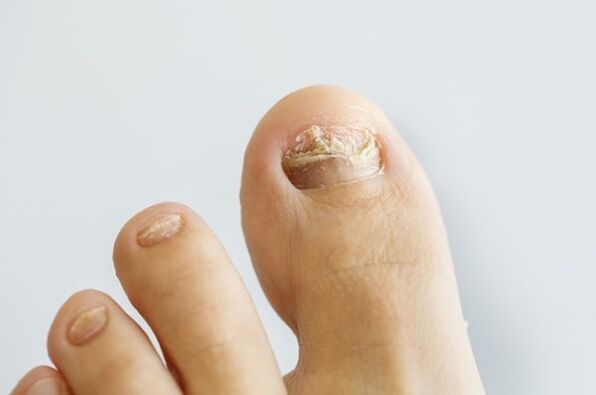
Causes of mushroom nail damage
The mushroom damage to the legs in medical practice are much more common than a similar disease on the hands.This is due to the fact that the lower limbs are in contact with the contaminated environment much more often.In this case, the main cause of the occurrence is reduced immunity.The weakened organism cannot withstand an infectious agent.
If we speak specifically about the fungus on the legs of the legs, there are a number of factors that contribute to infection:
- Visit public places without shoes.This applies in particular to baths, saunas and pools, showers in gyms or in production, hospital departments in a hospital.In the first two cases, the risk of infection due to the presence of such places by people who are carriers of a fungal infection is high.In addition, fungi multiply mushrooms in a damp environment.Despite compliance with the hygiene standards, hospitals are a concentration place of different infections, including fungus.After becoming barefoot on the ground in one of these places, the likelihood of getting an infection grows ten times.Even if none of the domestic onychomycosis was sick, conditional pathogenic mushrooms that live on human skin increase in the impossed bath.An increase in its population leads to unfortunate consequences.
- The wearing of old or other human shoes that are physically pathogenic mushrooms on the skin are inevitable.Microorganisms accumulate in tissue stories, which also increases the risk of infection.
- Wearing shoes is not seasoned - one of the infection factors is excessive sweating of the legs.When a person goes into closed shoes in summer or wears warm shoes in the room, the likelihood of mushroom damage increases.However, the periodic cutting of nails and the careless washing of the legs with soap may not be enough.It is important to cut the nails regularly, cut the ridge and push the cuticle, use special lotions and constantly clean the keratized skin layers.
- We speak of damage to the nail plate on our fingers with lines, bruises and cuts.In such cases, blood circulation is disturbed in the damaged area, the nail does not receive the right amount of nutrients.This can provoke the development of the fungus.This is due to the possibility of selecting medicines, showing activity in relation to a certain type of pathogen and the implementation of the most effective treatment.
- Dermatophytes
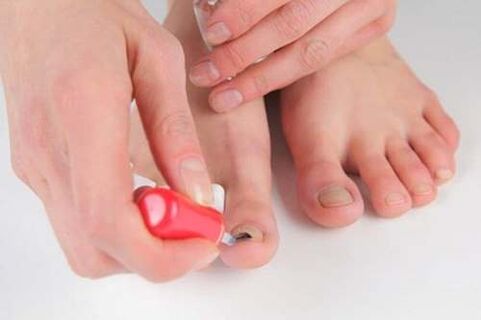
The most common type of pathogen.According to statistics, dermatophytes cause a mushroom on the nails of around 75-80% of cases.In this case, the condition of the immune system plays the main task when onychomycosis occurs.With normal immunity, mushroom damage to dermatophytes is almost impossible.
Merkmale der Behandlung hängen von der Identifizierung der Arten von Pilzen ab, die die Nagelplatte beeinflussen. Dies ist auf die Möglichkeit zurückzuführen, Arzneimittel auszuwählen, die Aktivität in Bezug auf eine bestimmte Art von Erreger und die Umsetzung der wirksamsten Behandlung zeigen.
Dermatophyten
Die häufigste Art von Erreger. Laut Statistiken verursachen Dermatophyten einen Pilz an den Nägeln von etwa 75-80% der Fälle. In diesem Fall spielt der Zustand des Immunsystems die Hauptaufgabe beim Auftreten von Onychomykose. Bei normaler Immunität ist fast unmöglich, Pilzschäden an Dermatophyten.
The infection comes from humans or animals that are carriers, as well as contact with the soil.Ceratinocytes, cellular structures of the epidermis, the high content of which is observed in the nails, are a popular nutritional medium of this type of fungus.
In the caste from dermatophytes, two main parts differ, mostly ashomycosis pathogens:
- red trichophytes (rubrum) - the beginning of the pathological process (external orFree) part of the nail, from where the infection gradually moves to the root of the nail plate.In most cases, this subspecies affects the toes.It is characterized by simultaneous damage to the nails on several fingers (often nearby).The characteristic signs of infection are the thickening of the affected nail area and its delamination.The skin dries and switches under the outer facet of the nail plate.
- Trichophyton is intergraded - in this case the white surfaces develops -onychomycosis.The most popular habitat of the subspecies is wet, it can often be found in bathrooms, bathrooms and pools.The causes are more often the thumb of the lower extremities, according to which he "captures" other nails.A characteristic feature is regarded as a focal damage to the nail plate with the occurrence of separate white spots or stripes.In the future, whitish areas will grow together and merge.When the forms of life of the fungus spread to other fingers, areas of the dried and peeling skin can be found between the fingers.
Hefe
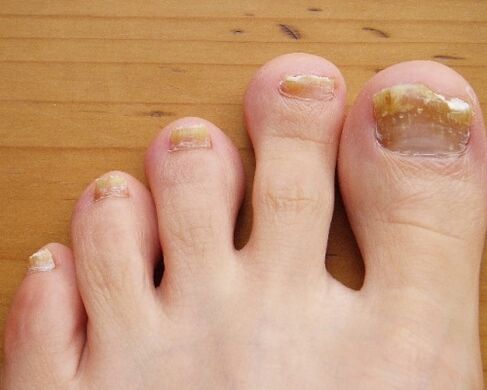
Another pathogen for mushroom damage on the legs on the legs is due to pathogenic fungi of the Candida family.They are considered conventional and pathogen because they constantly live on the surface of human skin.This means that contact with an infected person, an animal or an external environment does not require at all.In this case, the main trigger of the pathology is a significant decrease in immunity, immune deficiency.
In contrast to dermatophytes, yeast mushrooms do not form a myzel layer, i.e. the destruction of the nail plate with this form of damage occurs much less frequently.But the same factor makes the infectious lesion heavier because the beginning of the pathological process takes on the root (proximal) side of the nail.Such varieties of mycosis are considered more serious, but at the same time rare.
The first characteristic feature of the pathological process caused by yeast mushrooms is the detachment of the upper layer of the nail plate.For this reason, the nail loses its shine, becomes dull and rough.In about 7-10% of cases, nails appear with yeast mushrooms.
Forms
The most insidious type of mushrooms, since these forms of life are found almost everywhere (especially in a damp environment).The mushroom damage on the nail on the leg can cause about 35-40 subspecies of shapes.
Despite the prevalence in the environment, this form of onychomycosis is rarely diagnosed.In part, due to an atypical clinical image, it is also more difficult to diagnose and treat.Another reason for the complexity of the diagnosis of mold -onychomycosis is the ability of mold to form myzel, which benefits the clinical image to damage the dermatophytes.
The life forms of the fungus mainly affect nails on the legs, and the infection with subspecies is about 10-15%.Nail plates are slowly leading.In the initial phase, the mushroom can remain unnoticed at all.Nevertheless, there are symptoms of the early stages of the development of pathology that are important to pay attention to this:
Die meisten Arten von Pilzschäden an den Nagelplatten führen langsam voran. In der Anfangsphase kann der Pilz überhaupt unbemerkt bleiben. Trotzdem gibt es Symptome der frühen Stadien der Entwicklung der Pathologie, die wichtig sind, um darauf zu achten:
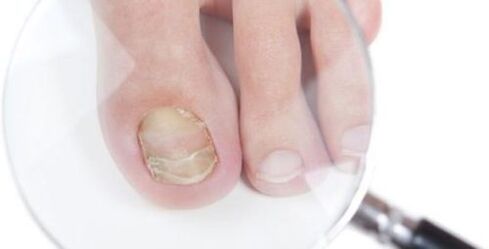
- Growth injury is the first and most inconspicuous sign.In a state of the norm, the nail on the leg grows by no more than 2 mm per week.The nail plate affected by the mushroom slows down the growth rate.
- Change the color - first the nails affected by the fungus fade, lose the shine and become matt.It also notices the appearance of white or yellow through the surface of the nail or a complete change in the color of the nail plate (white, yellow or brown are possible).Change color from the mushroom of the nail in the photo above.
- The formation of ridge and damage to the cuticle is another indirect attribute that indicates the lesion of the fungus of nearby skin.If the Burrs appear more often and the nail skin area is systematically inflamed or damaged, it is worth looking for a mushroom lesion.
- Thickening or thinning of the nail plate - variations depend on the damage to the specific types of fungi.
In the course of the pathological process, the symptoms become more obvious, it is more difficult to ignore it.The clinical signs of later stages of onychomycosis include:
- Change the surface of the nail plate - it gets rough and unevenly, littered with tubercles and waves.Similarities of crumbs can also occur on the nail, which indicates a gradual replacement of the upper nail layer.
- In the still later phase, the nail gradually begins to collapse.This is first expressed in the stratification of the nail plate, the appearance of cracks on the entire surface or chips on the outer edge.This is what this function of the mushroom on the legs of the legs in the photo.
- In the future, destruction is even more serious.The nail literally crumbles and has no time to grow.At the same time, the sub -gear sections of the dermis are exposed, and the remaining parts of the nail look significantly painful and unattractive.As a result, there is a risk of complete destruction or replacement of the nail plate.Heavy lesion with a nail fungus in the photo above.
The risk of complications
Many unpleasant sensations and the deterioration of the appearance of the nails of the legs are only the top of the iceberg.The lack of timely treatment threatens the development of complications under which the most common are taken into account:

- Allergic reactions - in certain stages of development, the fungus of the legs can be perceived by the body as an allergen.
- The mushroom damage can weaken the immune system of the body, the development or progression of a series of diseases, including systemic, provokes.To work together in the affected areas.As a result, inflammatory and purulent processes develop.
- In particular, serious cases that are longer and progressive of the disease can lead to the development of mushroom mycosis.In this case, the life forms of mushrooms can penetrate the blood and be distributed throughout the body.At the same time, it has so far been important to carry out diagnostics by sowing a bacterial environment in order to determine the type of pathogen and select the most effective medicines.An integrated approach includes the combination of different types of therapy, but sometimes this is not enough.
- Medicines
drug therapy is the basis for the treatment of most pathologies, including mushroom nail lesions.Depending on the development phase of the pathological process, two main groups of medication are used as part of the treatment:
Medikamente
Die medikamentöse Therapie ist die Grundlage für die Behandlung der meisten Pathologien, einschließlich Pilznagelläsionen. Im Rahmen der Behandlung werden je nach Entwicklungsphase des pathologischen Prozesses zwei Hauptgruppen von Medikamenten eingesetzt:
- Local type of effect - this includes ointments, gels, lacquer, creams, sprays and lotions with antifungal activity.The method, multiplicity and duration of the use of such drugs is determined by a doctor, in most cases they are used at least 2-3 weeks.
- Systemic antimotics - are required for the treatment of nail fungus in later advances.For the most part, these are tablets that penetrate the blood and inhibit the life of the mushrooms after suction from the stomach intestine tract.The use of systems is not only important to improve the therapeutic effect, but also to prevent relapses.
People's funds
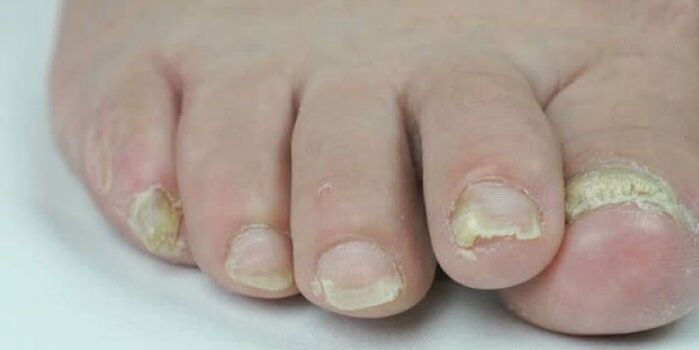
Traditional medicine is viewed as a auxiliary method to combat the mushroom on the legs.People's recipes can improve the antifungal effect.The most effective of them are considered:
- iodine - is able to dissolve protein structures that form the basis for life forms for fungus.For daily treatment, apply a few jod drops to the affected areas with a cotton pad every day.
- Peroxide is an effective antibacterial means that has a disinfection effect.To improve the effect, the peroxide is mixed in the same proportions with vinegar.Then the patient is lubricated with a mixture, it is not necessary to rinse them out.The procedure is repeated for 1-2 weeks every day.
- Celandine - The best method for using this plant to treat mushrooms on the leg nails is pack.To do this, take a tablespoon crushed raw materials (leaves and branches), pour 0.5 liters of water and bring them to cook.The decoction is defended within 15 to 20 minutes, according to which the legs fell for another 20 to 25 minutes.Repeat the process every day before going to bed for 2-3 weeks.
Remove nail
In medical practice, the chemical method is mainly used to remove the nail plate.For this purpose, special aggressive medication is used, the procedure is carried out by a doctor in order not to damage healthy areas of the nail plate and the skin.This method is painless and effective, and signs of its use are the lack of the results of conservative treatment or advanced cases of onychomycosis.
Laser therapy
The process includes partial or complete removal of the nail plate.The choice of the method depends on how deep the fungus has penetrated into the structure of the nail.In the course of the laser therapy, an intensive laser radiation method is used.A special apparatus is removed with a mushroom layer of the nail, according to which an antifungal course follows.
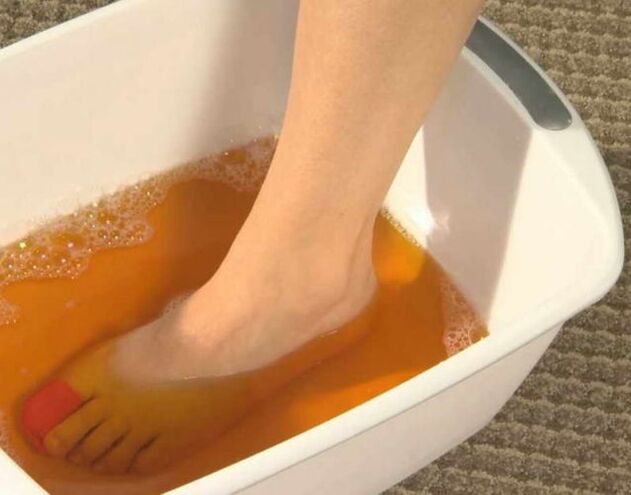
The complete removal of the nail plate with a laser is required if the nail is completely affected by the fungus.In this case, an association is applied to the bare skin areas after the distance, under which an ointment or cream can be laid with an antifungal effect.Removing the nail plate requires regular visits to the doctor to carry out associations and monitor the growth of the new nail plate.
The laser treatment of nail fungus on the legs in which only a few layers of the nail are removed are required within 7-10 interventions (about 10 to 15 minutes are required to process each nail).When the distance is displayed, the process disappears and takes about 20 minutes, the patient has no pain.



















